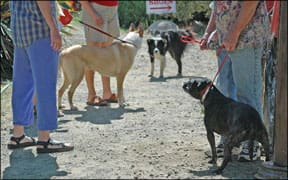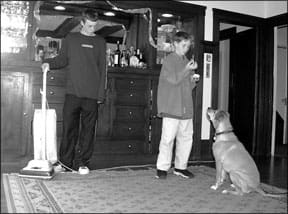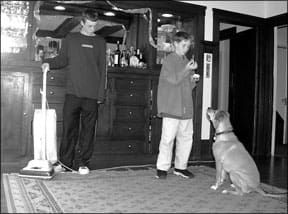President Franklin D. Roosevelt, speaking about the Great Depression, said, “We have nothing to fear but fear itself.” If only it were that simple when dealing with dog behavior!
Fear-related canine behaviors can be debilitating to the inappropriately fearful dog. They are heartbreaking, frustrating, even sometimes dangerous for the human trying to deal with her dog’s strong emotional responses, and for the dog who may injure himself or others in his desperate efforts to escape or protect himself from the fear-causing stimulus. Fortunately, there are steps an educated owner can take to decrease the intensity or frequency of her dog’s debilitating fright.
Three faces of fear
The complex of fear-related behaviors includes fears, anxieties, and phobias. While they are closely related emotional responses, they differ significantly in several ways, including the presence or absence of a physical trigger, the intensity of the dog’s response, and the ease with which the emotional response and related dog behaviors can be modified. In general, these three conditions can be among the most difficult of behavioral problems to treat.

There is a strong genetic component to fear-related behaviors. Whereas once we tended to place a lot of the blame on owners for their perceived role in creating fearful dogs, today we recognize that a genetic propensity toward fearfulness is a significant factor in the actual manifestation of fear-related behaviors.
While environment – especially lack of socialization – can play a critically important role in bringing these behaviors to fruition, genes explain why two dogs with similar upbringing and socialization can react so differently in the presence of a potentially fear-causing stimulus, and why even a well-socialized dog can suddenly develop phobic behaviors.

Fear is defined as a feeling of apprehension associated with the presence or proximity of an object, individual, or social situation. It’s a valuable, adaptive emotion, necessary for survival and appropriate in many situations. It’s good to be afraid of grizzly bears, tornados, and semi-trucks skidding out of control on icy highways. Your dog is wise to fear the flashing heels of a galloping horse, strong waves crashing on an ocean beach, the spinning wheels of a passing car. People and animals who feel no fear are destined to live short lives.
Of course, overly fearful dogs may lead short lives as well. Fear-related aggression is a significant risk to a dog’s long and happy life. A fearful dog’s first choice is usually to escape, but he may bite defensively if cornered or trapped, and dogs who bite are often euthanized. In addition, a constant emotional state of fear makes for a poor quality of life for a dog, and for humans who are stressed by their fearful dog’s behavior.
Debates about anthropomorphism aside, most biologists agree that human and nonhuman mammals experience fear similarly. Recall one of your own heart-stopping, adrenalin-pumping life experiences. Perhaps you were approached by a menacing stranger in an alley on a dark night, threatened by a large predator on a camping trip, cornered by an angry bull in a pasture, or just missed rear-ending a car in front of you when a moment of inattention caused you to miss the warning flash of taillights. Remember how helpless, vulnerable, and terrified you felt? You can empathize with your dog when you see him trembling in the presence of a stimulus that elicits a similar response in his canine brain and body.
Anxiety is the distress or uneasiness of mind caused by apprehensive anticipation of future danger or misfortune, real or imagined. Anxious dogs appear tense, braced for a threat they can’t adequately predict, sometimes one that doesn’t actually even exist. Anxiety can be a chronic condition, one that significantly impairs a dog’s (and owner’s) quality of life, and one that can be more challenging to modify than the fear of a real and present danger.

Separation distress is perhaps the most widely discussed anxiety-related behavior in dogs, but owner absence is not the only cause for canine apprehension. Many dogs are anxious on car rides – anticipating, perhaps, a visit to the vet’s office, or some other “bad” place. A dog who has been attacked by a loose dog while walking on leash may become anxious about going for walks, constantly stressed, scanning the neighborhood for another potential attacker.
Again, human anxieties are similar to canine. If you’ve been mugged in a dark alley, you are likely to experience some degree of stress anytime you find yourself walking down an alley in the dark. Some people experience extreme anxiety over taking exams, even when their past successes show that they pass tests with flying colors. Barbra Streisand, successful singer that she is, suffers from extreme performance anxiety, still becoming physically ill every time she’s about to walk on stage. The danger or misfortune may be imagined, but the anxiety is very real.
Phobias are persistent, extreme, inappropriate fear or anxiety responses, far out of proportion to the level or nature of threat presented. They are stubbornly resistant to modification through habituation or desensitization – repeated low-level exposure to the stimulus that causes the extreme response. While inappropriate in degree, a phobic response is not totally irrational – it is usually directed toward something that could be harmful. Common human phobias are related to snakes, spiders, high places, flying – all things that have the potential to be life-threatening. In reality, the majority of snakes and spiders are relatively harmless, it’s rare for humans to accidentally nosedive off a skyscraper, and only a tiny percentage of airplanes ever crash. Common canine phobias include extreme reactions to thunderstorms and other sounds, fear of humans, and inappropriate response to novel stimuli (anything new and different).

Lucy and the parade
When we adopted Lucy, our Cardigan Corgi in June 2004, one of the things that appealed to me was her obvious self-confidence. This was a dog, I thought, who could travel with me to seminars, appear in public, perhaps even compete in Rally or Agility, or both. I worked on socialization, taking her places with me whenever I could. She took it all in stride, just as I anticipated – until I made the mistake of taking her on the Humane Society of Washington County’s Halloween Parade float. I thought she was old enough at nine months to handle the parade environment. I was wrong.
The parade is the pride of Hagerstown, Maryland – an all-afternoon and evening affair as floats and marchers get lined up and ready to move through the center of town. Lucy was enjoying the commotion, eating yummy treats as we strolled past stationary floats, greeting people and practicing socialization and good manners behaviors. With the signal that it was time for the parade to begin we hustled back to the float, loaded up, and settled in our seats along with a half-dozen other dogs and their handlers.

Lucy continued to enjoy the attention as we rolled along the spectator-lined street. People of all sorts walked up to the slow-moving float and petted her. Her ears were up, her eyes bright, and her tail wagging merrily. Then she heard the drums. I hadn’t realized our street would merge with the marching band street. I watched helplessly as my confident Corgi melted down before my eyes. Her ears flattened back against her head. Her tail went down, her eyes lost their shine, and she began to tremble, rapidly losing her enthusiasm for the treats she had been happily enjoying.
Then I made my second big mistake. We should have bailed out of the parade at that point and arranged for someone to come back and collect us after the festivities were over. Instead, I opted to stick it out, hoping to use my higher-value treats to counter-condition and desensitize her fear response to the drums.
Unwittingly, I achieved the exact opposite result; the constant exposure to the too-intense stimulus effectively sensitized her to loud noises, increasing her fear response. That sensitization caused her to be intensely sound-phobic, which has since generalized to thunderstorms, the banging of our horses in their stalls in the barn, and worse luck, cheering and applause.
Getting brave
Whether you’re working with fears, anxieties or phobias, the solution to an inappropriate emotional response is counter-conditioning and desensitization (CC&D) to change your dog’s emotional response to the stimulus or situation. In The Cautious Canine, author and behaviorist Dr. Patricia McConnell calls counter-conditioning a “universally effective treatment for fear-based behavior problems.” Think of it as training your dog’s emotions rather than training his actions. Behavior change will follow emotional change.
Counter-conditioning involves changing your dog’s association with a scary stimulus from negative to positive. The easiest way to give most dogs a positive association is with very high-value, really yummy treats. I like to use chicken – canned, baked, or boiled, since most dogs love chicken and it’s a low-fat, low-calorie food. Perhaps your dog is afraid of your vacuum cleaner. Here’s how the CC&D process works:
1. Determine the distance at which your dog can look at the non-running, stationary vacuum cleaner, and be alert and wary but not extremely fearful. This is called the threshold distance.
2. With you holding your dog on leash, have a helper present the non-running vacuum at threshold distance X. The instant your dog sees the vacuum, start feeding bits of chicken, nonstop.
3. After several seconds, have the helper remove the vacuum, and stop feeding chicken.
4. Keep repeating steps 1-3 until the presentation of the vacuum at that distance consistently causes your dog to look at you with a happy smile and a “Yay! Where’s my chicken?” expression. This is a conditioned emotional response (CER); your dog’s association with a non-running vacuum at threshold distance X is now positive instead of negative.
5. Now you need to increase the intensity of the stimulus. You can do that by decreasing – in tiny increments – the distance between X and your dog, by increasing the movement of the vacuum at distance X, or by turning the vacuum on. I’d suggest decreasing distance first in small increments by moving the dog closer to the location where the vacuum will appear, achieving the desired CER at each new distance, until your dog is happy to be right next to the non-running, non-moving vacuum, perhaps even sniffing or targeting to it.
6. Then return to distance X and add movement of your non-running vacuum, gradually decreasing distance and attaining the desired CERs along the way, until your dog is delighted to have the non-running, moving vacuum in close proximity.
7. Now, back to distance X, with no movement. Have your helper briefly turn on the vacuum; you feed the dog treats in that instant. Turn off the vacuum and immediately stop the treats.
8. Repeat until you have the desired CER, and then gradually increase the length of time you leave the vacuum running, until your dog is happy to have the vacuum on continuously.
9. Begin decreasing the distance between the dog and the vacuum in small increments, moving the dog closer to the vacuum, obtaining your CER consistently at each new distance.
10. When your dog is comfortable and happy to have the running, stationary vacuum close to him, you’re ready for the final phase. Return to distance X and obtain the desired CER there, with a running, moving vacuum.
Then – gradually! – decrease the dis-tance between the vacuum and your dog until he is happy to be in the presence of the running, moving vacuum. He now thinks the vacuum is a very good thing, as a reliable predictor of very yummy treats.
The above example concerns a fairly simple fear behavior. The more complex the stimulus and the more intense the response, the more challenging the behavior is to modify. Anxieties and phobias generally require a greater commitment to a longer term and more in-depth modification program, and often beg the intervention of a good, positive behavior professional.
What about medication?
I used to be strongly opposed to using drugs in behavior modification except as a very last resort. That was years ago, at a time when the most widely used drugs were valium and acepromazine. Those drugs have a strong sedative effect – creating a “groggy doggie” who is still very aware of the fear-causing stimulus, he’s just too drugged to do anything about it. Still inappropriately prescribed by some vets today for behavior modification, they are quite likely to make fear-related behaviors worse, not better.
These days, I’m much more likely to suggest consulting with a behavior-educated vet sooner, rather than later, about the use of behavior modification drugs.
I’m not a vet, so I can’t prescribe drugs; in fact, it would be inappropriate for me to even suggest to a client that a specific drug might be just what her dog needs.
What I can do is tell her that based on the behavioral history form she has filled out for me, my observations of the dog, and our subsequent discussions regarding the success of our behavioral modification program, it’s appropriate to talk to a veterinarian about the possibility of adding pharmaceuticals to our modification program. I am most likely to suggest this in cases where dog’s and owner’s quality of life are significantly impacted by a dog’s fearful and/or aggressive behaviors.
Today’s classes of psychotropic drugs are a far cry from the sedatives of the past. They are designed to help repair brain chemistry that’s out of kilter – to open a window in the dog’s brain that will enable ongoing behavior modification to be more successful. Admittedly, it’s a little experimental; most of the drugs were designed for use in humans, and use in canines is an off-label application – more reason to work closely with a veterinarian who is very knowledgeable about canine behavior.
People tend to have a knee-jerk “cringe” reaction when someone suggests “drugging” their dog. I understand and applaud a dog owner’s caution; behavior modification drugs are not benign, and they need to be used with care. There is potential for adverse reactions, and the dog needs to be monitored closely to determine if the drug’s impact is beneficial, neutral, or harmful to the dog.
That’s why I believe that any canine candidate for behavior-modifying drugs needs to have an observant owner, a know-ledgeable behavior professional, and a behavior-educated veterinarian on his team. So don’t automatically say “No!” to drugs; just use them wisely, and with care and assistance from your animal behavior professionals.
For more information about the medications most frequently prescribed for fear and anxiety in dogs, see “Understanding Behavior-Altering Drugs For Canine,” July 2006.
The damage done
I frequently chastise myself for taking Lucy to the parade. In my defense, I didn’t realize we would meet up with loud drums – and plenty of dogs without a genetic predisposition for sound-phobia would have been fine with the noise. In fact, because of the genetic influence, there’s high likelihood that Lucy’s noise phobia would have been triggered sooner or later anyway, perhaps by a very intense thunderstorm.
The good news is that my husband and I have made some progress with Lucy’s sound-phobia. Loud television programs offer ideal opportunities for counter-conditioning and desensitization, as do recordings of thunderstorms and applause, where the intensity of stimulus (volume) can be controlled.
Real thunderstorms are another story, however. They inevitably are super-threshold – occurring at an intensity that triggers a strong emotional response, trembling and shutting down to a degree where she can no longer accept high-value treats. For those, we’ve added melatonin, a snug T-shirt (the economy version of an Anxiety Wrap,™ a product that operates on the concept of “swaddling” as a comforting device), a Comfort Zone® plug-in “dog appeasing pheromone” diffuser, and the use of an anti-anxiety drug (Alprazolam) obtained through consultation with our behavior-knowledgeable veterinarian.
We’re considering the purchase of a Storm Defender™ cape (a coat that neutralizes the static charge that accompanies thunderstorms) to see if it might be even more effective than the snug T-shirt, and we may use a Calming Cap™ (a mask that reduces the dog’s vision and thus reduces his visual stimulus) to reduce the intensity of stimulus of lightning flashes. We’re encouraged by Lucy’s improvement, and hope for the day when she’s no longer traumatized by storms and applause. We might even make it to the Rally ring one day.







I have 2, bro. N sister mix border collie w Shepard n ?good dogs seem very happy,lately he growls softly not showing teeth when I pet him don’t know wats wrong,he growls ready 2 eat nothing is different,except his ears go back walk slow, but after awhile he’s ok I’m puzzle please help